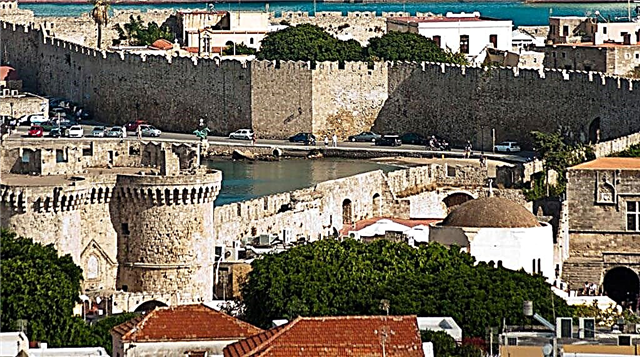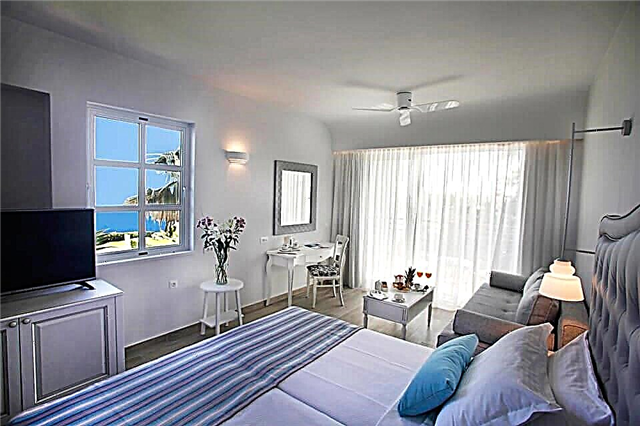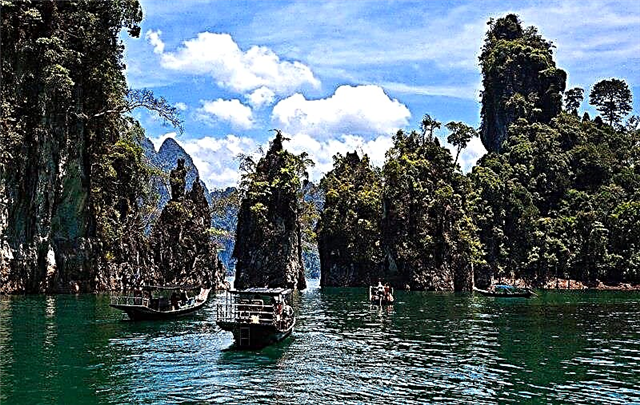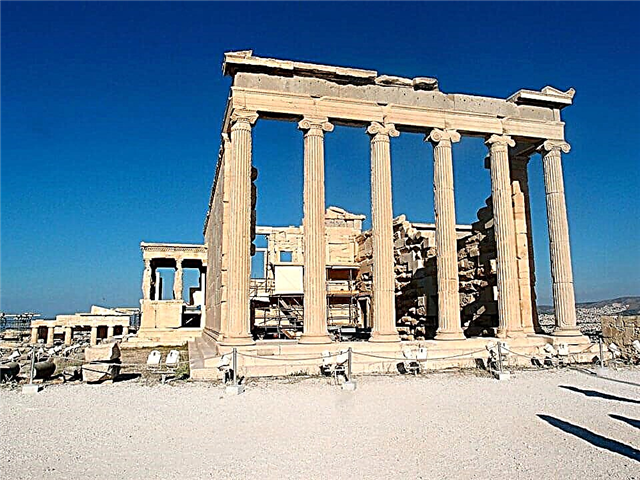Travel to Greece primarily attracts with wonderful resorts, recreation conditions among beautiful nature, gentle sea waves. And you always want to find time to explore its ancient sights. Athens, as one of the most interesting capitals in the world, raises the eternal question: what to see in Athens in 2 days on your own? You cannot see, tell everything about this city in a short time. Using useful advice, taking photographic equipment, comfortable shoes, water, a map of the city with specific routes, you can explore the most interesting places of the ancient city, born in the 15th century BC, in two days. For effective sightseeing of compactly located attractions, it is proposed to use a tourist bus with an audio guide and pass part of the route, saving time and energy during an interesting journey.
How to get from the airport to the center

There are several options for getting to the city center from Eleftherios Venizelos International Airport. The choice depends on the composition of the group, luggage, financial capabilities. It is useful to get acquainted with the prices, type of travel in advance:
- By bus X93, X95, X96, X97. The boarding station is located between the halls for exits No. 5, 4. Comfort buses operate around the clock. Travel time is 1 hour 15 minutes. The ticket price is 10 €.
- Metro. Ride on the trains of the blue metro line for 1 hour. A one-way ticket costs 10 €. After composting, it is valid for 90 minutes. All signs are in Greek, which makes it difficult to read on your own. The metro entrance is located opposite exit number 2 from the airport building.
- By train. Travel time is slightly less: 40 minutes. You pay 10 € for a ticket. The train platform is located next to the metro entrance.
- Transfer. For a distance of 35 km (40 minutes drive) they pay from 42 €. A trip by minibus for 7 passengers will cost 85 €. When booking a taxi in advance, it is suggested to hold a sign with the name and be at gate 3 of the arrivals terminal.
- By public transport.
First day

Walking along the main city street, it is difficult to resist the offers of numerous shops, boutiques, cafes. We must find the strength and pass by. The most interesting elements of the city are not found here. Every street, old house, stone of ancient ruins is filled with the history of the past centuries. You can discover its secrets, mysteries and beauty in different places. Most often, an accelerated 2-day route leads to the central square of the city.
Syntagma Square and the change of Evzones

At the beginning of the 19th century, on the site of the modern Constitution Square Syntagma, there was a green lawn in front of the royal residence. Gradually, fountains, structures of white marble appeared, permission was born to visit it for all residents of the city. Now it is one of the most visited places with a magnificent Palace of Parliament, a monument to the Unknown Soldier, copies of statues from the Neapolitan Museum, old white marble steps leading to Amalias Avenue.

Beginning in March 1932, the square has been invited to watch the unforgettable beauty changing of the guard of the Presidential Guard (Evzones). It runs every hour from 55 minutes and lasts 10 minutes. The ritual is especially beautiful at 11 o'clock every Sunday. To the sounds of a military orchestra, strictly practiced movements, actions of members of the composition of the guards army pass. Admiration, curiosity is aroused by the clothes of the Evzones. Its first version was adopted in 1833. Individual elements (tailcoat uniform, skiver) are borrowed from the Bavarian style.
Later, a unified form began to be used with the use of traditional differences. Among them are the famous "Tsarukha" boots with numerous nails driven into the sole. They "click" beautifully while driving. Fluffy pom-poms (tribbles) give them a mysterious look. Interestingly, in ancient times, sharp knives were hidden under them. After a colorful shift, it is allowed to take a picture against the background of the bright outfits of real Evzones.
National garden

Walking around Syntagma Square, just look at another attraction - the National Garden. It is located next to the parliament building. The entrance to the "Royal Park", planted during the reign of the first queen of the independent country Amalia in 1839, is offered through any of the four entrances. The main entrance is on Amalias Avenue. Over 15,000 plant species grow among the park's luxurious alleys, 140 of which have already celebrated their 100th anniversary.

The gardener Schmidt supervised the creation of the park. The garden's layout uses original thematic compositions based on a harmonious combination of plants and antique ruins, columns, mosaics. In the southern part of the garden, there are sculptures of famous poets of Greece, the first ruler of the country, Kapodistrias. An ancient aqueduct rises in the depths of the garden.
On the well-groomed territory of the park (its size is about 16 hectares), there are nooks for animals, beautiful ponds, playgrounds for children's games, with swings, slides, comfortable benches for rest. It is allowed to relax on the green lawns of the park. There is a cafe on the territory of the garden where you can have a snack with the whole family. The National Gardens are listed as Historic Monuments.
Zappion Palace Building

A natural continuation of the territory of the National Garden is the Zappio Park. It is decorated with the famous palace, built in 1888 at the expense of the famous Greek philanthropist Evangelos Zappas, according to the project of Hansen (originally the architect Boulanger was engaged in it). The building was built in neoclassical style with decoration in the form of Corinthian porticoes. It harmoniously combines with the architectural forms of the stone bridge of Ilissia, built at the expense of the same patron. The palace is located next to the Parliament building on Syntagma Square.
The main reason for the creation of the building was the desire to revive the famous Olympic Games of antiquity. This is the first building in the world built for this purpose. During the 1896 Olympic Games, the palace building was used as the "Olympic Village" and as halls for fencing competitions. Now the palace hosts trade fairs, exhibitions, conferences, symposia, concerts, events related to the political life of the country. The results of elections are announced in the palace, meetings of heads of different states are held.
Callimarmaro Stadium

Traditions of the transmission of the Olympic flame, the opening of the games by the head of the country, and the performance of the Olympic anthem have become commonplace for a long time. They were born here at the Kallimarmaro or Panathinaikos stadium, on the site of the ancient structure of the central part, found during archaeological excavations in 1836. The almost forgotten stadium of Herodes Atticus has been restored in the most similar way to the original marble structure. It was created in 329 BC. NS. at the suggestion of Lycurgus in the site of an ancient wooden stadium.
The first modern Olympic Games were held at the stadium in April 1896. The image of the stadium is on the obverse of the Olympic medals, collectible coins worth 100 €. Elements of the past decorations of the stadium have survived to this day. These are: pillars of marble, crowned with sculptures of Apollo, Hermes, starting plates, from where the first athletes of the distant Olympic Games began to compete. The world's oldest stadium can accommodate 45,000 fans.
The stadium has gone through a complex history and keeps many secrets. One of them was the discovery of 31 ancient tombs before restoration for the games held in 2004.It is assumed that these are the remains of athletes from the 3rd – 4th centuries. AD Surprisingly, there is still an opportunity for anyone to run on the running tracks of the unique stadium. To do this, you need to fill out a special form and come here at 7.30 am.
Temple of Olympian Zeus

The desire of the tyrant Pisistratus to overshadow the greatness of the temple of Artemis, was realized in the most impressive structure of the ancient world, the Temple of Olympian Zeus. Now you can see only the ruins of a magnificent building. Fifteen columns have survived (out of 104, the last 16th column fell during the storm of 1852). Historians suggest that the main destruction of the Temple occurred in the Middle Ages as a result of strong earthquakes.
Today the ruins are protected by the state and are historical landmarks. You can see them at a certain time with the purchased ticket of the archaeological museum. The first excavations of the Temple were carried out in 1889-1896. It is proven that it was built from the beautiful marble of Mount Panthepus. The length was about 96 m. The height of the columns reached 17 m, the thickness was 2 m.
The figure of Zeus was considered one of the wonders of the world. There is a legend that tells that the ancient architect Phidias, after finishing the work, asked Zeus "Is he satisfied with the work." A thunderbolt struck in approval, and a crack formed at the feet of the sculptor. The figure of Zeus at the site of the sanctuary, the ancient cultural center has long been gone. Some of the original elements of the temple, found during excavations, are preserved in the Archaeological Museum of Olympia.
Arch of Hadrian

On the way to the temple of Zeus, one cannot fail to notice the ancient arch, built in 131 AD. The building was erected in honor of the Roman emperor Hadrian. He appreciated the culture, art, philosophy of the country. His favorite city was Athens. During his reign, the territory of the city increased significantly, the region of Adrianopolis appeared. The Arch of Hadrian, reminiscent of the Arc de Triomphe of Rome, adorned the entrance to the new city along the road from the old part of Plaka. Now she goes to Amalis Avenue. The structure was built from solid Pentylikon marble.
The snow-white color of the mineral in the rays of the sun lights up with a golden hue. Many ancient buildings of the city were built from this mineral. The height of the arch is 18 m. On the sides there are pilasters ending in capitals with the image of the Corinthian order. The corners of the arch are decorated with taller pilasters. Columns, a triangular pediment, inscriptions from different sides (on the western part “Here is Athens, the former city of Theseus” and on the east side “Here is the city of Hadrian, not Theseus”) have been preserved on the ancient structure.
Acropolis of Athens

The oldest part of Europe can be seen at the site of the greatest sanctuary, the plateau of the upper city called the Acropolis. It is often called "Cecropia", named after the first king of Athens, according to the existing legend. Here the myths of ancient Greece were born, religious ceremonies, holidays were held, monuments were erected that have become the eternal landmarks of the world. Elements of a complex architectural ensemble harmoniously blended into the surrounding landscape and became classics of the architecture of ancient builders who influenced world culture.
The first buildings appeared on a rocky hill in the sixth millennium BC. The Royal Palace, the defensive fortress of the Citadel became the center of the ancient kingdom. After the appearance of the famous Temple of Athena Polias, the Acropolis acquired the status of a sacred place. Since that time, monumental buildings and ruins began to appear on the slopes of the hill, which are still surprising today.
Among them is the famous Parthenon, which has become the hallmark of the country. Temples Erechtheion, Niki Apteros, Propylaea, Roma and Augustus. Odeon of Herodes Atticus, portico of Caryatids, Bravroneion, theater of Dionysus. At the foot of the hill there is an interesting museum with artifacts dedicated to the history of the ancient area of Athens. Among them are statues of the famous caryatids of Ereheyton, Athena Mourning.
Hill of the Muses

After relaxing in a restaurant on the territory of the Acropolis, admiring the extraordinary panorama of the city, an independent journey continues along the places of walks of ancient thinkers. After overcoming an easy ascent to the Hill of the Muses to the monument in honor of the religious leader of the 2nd century Julius Filiopappus, you can once again look at the Acropolis, the port of Piraeus, the highest mountain of the city of Lycabettus, the ancient Agora. There is an opinion of the historian Pausanias that the monument is located at the burial place of the famous polymath, poet, musician, philosopher of antiquity Museus.
The modern monument to the ball was discovered during excavations in 1848. It stood on a large marble pedestal and was decorated with a sculptural composition with figures of relatives and Philopappus himself. On the hill there is a semi-wild park with numerous pines, olives, bats. There are no cafes, restaurants for recreation, paved paths, and numerous lanterns. From this hill, an order was given by the military leader Francesco Morosini to shoot at the Parthenon, where a Turkish armory was equipped. Almost half of the building was destroyed by cannons. Tourists often climb special stairs at night to get beautiful night shots.
Socrates' prison

Descending from the Hill of the Muses, one must carefully examine the mysterious entrances to the rocky caves, closed with an iron lattice. According to the existing legend, this is the premises of the prison, where the famous Socrates was held for 30 days awaiting the death sentence of the court. Convicted of dissent, he himself had to choose the form of the death penalty for himself. Which he did, having poisoned himself with poison. The dungeon cave was not specifically designed for a prison. According to many historical versions, it was a residential building, several stories high and carved into the rock by local residents in the 4th century BC.
The stone steps and interior rooms have been preserved to this day. In the minds of people, the caves have lived for many centuries as the dungeon of the legendary philosopher of ancient times. The monument is called the conditional "prison of Socrates". There is a legend that within the walls of the prison Socrates talked with his friend Crito. In joint conversations, his system of knowledge of the world through dialogue developed. During the war, the caves were used to store priceless artifacts from the National Museum. By the way, the modern monument to Socrates is located near the building of the Academy of Sciences.
Pnyx Hill

A small rocky hill located near the city center is of historical value. In ancient times, this place hosted meetings of the first democratic body of power (ecclesia) in the history of world mankind. The “Council of Elders” of the city court was in operation. Since the 6th century BC, the popular assembly of the famous Attica met here. In this place, the foundations of modern democracy were born, its institutions were formed.
Massive voting took place, in which thousands of people participated. Decisions were made about military operations against other countries. A part of the tribune, from which ancient orators spoke, has been preserved. The park is fenced and is considered an object of cultural and historical heritage. You can get into it without paying. A beautiful view of the highest mountain of Athens, Lycabettus, Acropolis, Areopagus hill, Agora opens from the height of the hill. The hill is considered one of the favorite walks of the locals.
Plaka

The first day's journey continues in the oldest district of Plaka. There are many souvenir shops, shops, restaurants. In any city, a walk through the old streets is a great pleasure. The spirit, the atmosphere of the ancient life of the city is felt on them with extraordinary power. Especially in this area, where ancient buildings were built on the foundations of ancient buildings, retaining their attractive power. Many residents have received new housing in modern neighborhoods, donating ancient structures for the area's many museums. The central square of Plaka is called Filomousos.
So it was named in 1813 by representatives of the ancient Society of fans of the muses (nine goddesses). An interesting children's museum is located on the ancient street Kidafenion. The old interior has been restored, it is proposed to try on old clothes. In the area you can walk along the oldest street, Hadrian. Its direction has not changed since ancient times. Loud music, fun in nightclubs and casinos are prohibited in the area. It is considered a calm area of measured relaxation.
Bar Tour: Greek Wine with Style

At the end of the first day of exploring the city on your own, it's time to relax, get ready for your next journey and taste real Greek wine. It is better to do this together with the Russian-speaking guide tripster.ru, who will help with the choice of the place of rest. He will tell you about the history of wine making in Greece, introduce you to wine styles during a walk with a winemaker. Along with the filled glasses during the evening tasting, it is pleasant to hear the history of the emergence of some styles of wine:
- Assyrtico Santorini. White wine from grape varieties growing near the volcano. It is highly acidic and can be stored in bottles for a very long time.
- Nemea. It is made from fruits that grow near the legendary city of Nemea, where Hercules defeated the lion (that's why the wine is called “the blood of Hercules”).
- Naousa. Wine with a tomato, olive aroma that can be aged for half a century.
- Moskhofilero. The aroma of roses, pleasant pink color and great taste characterize the wines of this style.
The story contains interesting facts from ancient wine technology. Information about the specialties of Mediterranean wine styles. How the French invention of glass bottles came into being.
Second day

In the ancient city and its surroundings, there are many interesting natural attractions, architectural structures erected in our time. Some of them are offered to be seen on the last day of exploring Athens.
Walk on the rooftops

The city, standing on 12 hills, has many places from which you can see the surroundings, streets, buildings. There are always a lot of people who want to see the beauty from a bird's eye view. They are invited to use the viewing platforms on the hills of the city, high buildings. The roofs of bars, restaurants, high-rise buildings provide a fascinating walk through the city at night. You can use the roofs of the buildings in Monastiraki Square.
All roofs of high-rise buildings, located at different levels, are safe and comfortable for walking. The sights seen from them are as if others, flying above the ground and revived, despite their ancient age. Fans of "original walks" can sit on the roof, drink coffee and see at once the whole wonderful city, the silhouettes of mountains, sea vessels.
Cultural Center of the Stavros Niarchos Foundation

Sometimes the architectural ensemble, which appeared in the XXI century, is called the "Modern Acropolis". An architectural wonder, built with modern materials and new technologies, is located near the port of Piraea. The original project was authored by Renzo Piano (financial support from the Stavros Niarchos Foundation, descendant and heir of the Greek shipowners). In his idea, the harmony of visual contact with the sea and the beauty of an artificial hill with an unusual building were realized.
It seems to grow out of the sea and sparkle with an unusual roof next to the clouds. Trees, shrubs, bright flowers continue to grow on it. A man-made park with an area of about 210,000 square meters has been created on the roof. The ensemble houses the National Library Buildings and the Opera House. The auditorium accommodates 1400 seats and another 400 seats are located in the plastic and dance theater.
The complex was opened in 2017. The glass hall of the library is located at the top of the 8-storey building. It offers an extraordinary panoramic view of the city. The roof of the building is made in the form of a curved wing of an aircraft, made with a special material that can withstand earthquakes.
Flisvos Marina

The name Attica means “coastal country”. The relief of the coast has lagoons, harbors used for yachts and ships. Now the marinas of Attica, with a well-protected water area, are used for private ships, servicing charter flights. Among them, Marina Flizvos is considered the main port for luxury yachts on the east coast. The harbor has 303 berths. Each is equipped with electricity, water. There is a convenient refueling station with the necessary fuel, Internet access, shower, toilet. The harbor entrance is indicated by luminous signs.
The territory is clean and well-groomed. On the bank, surrounded by high curbs, there are benches for rest. Marina Flisvos is considered to be one of the most popular walks. In the evenings, music sounds here, numerous cafes, restaurants work, lights sparkle, illuminating the sea, beautiful yachts. There are many play areas for walking with children. There is a seaside park next to the pier, adding to the festive atmosphere of the harbor.
Lake Vouliagmeni with thermal springs

At a distance of 21 km there is an interesting natural landmark, the secrets of which are just beginning to be revealed. Myths, legends of antiquity are not associated with it. As scientific research shows, the lake, which stores a complex system of karst caves, underground currents appeared much later. Thermal lake up to 20 m deep, connected with the volcanic arc of the area. At its bottom, springs with water containing excess sulfur are gushing. Warm, healthy water attracts many people all year round, despite the myth of the lake's mermaids abducting young children.
14 tunnels were found in the lake. One of them is considered the largest in the world. Due to repeated accidents during the diving of divers, now only scientific groups are allowed to explore the bottom. Aerial photographs found in the lake caves, rocky wells, a stalagmite, considered the largest in the country. A species of fish was found in the lake that can cleanse human skin (Doctor fish). There is a nice beach near the lake. A doctor and a rescue team are on duty around the clock. The place of relaxation is a favorite recreation area of the townspeople.
Cape Sounion

At the southernmost point of the peninsula (at a distance of 65 km) is Cape Sounion, famous for ancient legends and myths. The ruins of the ancient Temple of Poseidon rise on a cliff open from the Aegean Sea. It was from this place that King Aegeus gazed at the sea, waiting for the return of Theseus' son on ships with white sails. This should have been the case in the event of a victory over the Minotaur. Unfortunately, the son forgot to change the sails and the king, seeing the black color, threw himself into the sea. After some time, the inhabitants erected in this place two temples dedicated to the main deities of Greece: Poseidon and Athena.
The temple of Poseidon, the lord of the seas, stood at the peak of the cliff from 490 to 480 BC. The sanctuary was destroyed during the battle with the Persians. Now its ruins (15 columns on a massive base) are considered the best preserved of the architectural buildings of that time. During archaeological excavations in 1994, the ruins of the central street, the sanctuary of Athena, were discovered. A visit to Cape Sounion helps to understand how life went on the coast of the sea, named after one of the first rulers of Athens, the legendary king of Attica.
Sunset on Lycabettus Hill

The highest place in the city is on the Lycabettus hill (Lycabettus, Lycabettus). A natural formation with a height of about 233 m is located in the center of the city, which allows you to see its beauty in the maximum view. In sunny weather, even the Acropolis, the Kallimarmaro stadium, the port of Piraeus, and the nearby islands are visible. A beautiful legend says that this boulder in the city center was brought by the goddess Athena to raise her temple to the clouds. Hearing bad news from two black birds, she threw a boulder to the ground.Since then, he has been in the center.
It is sometimes called "wolf's hill" because of the habitat of a large number of animals. At the top of the hill there is an observation deck, the oldest bar serving wines of Greece. A small chapel of St. George, built on the site of the ancient temple of the Prophet Elijah. There are always a lot of people here on Easter days. Thousands of candles are burning and believers descend from the hill with them. You can climb the hill on foot, on the lift. An unforgettable sunset on the Lycabettus hill will leave a special impression of the city and invite you to come here again.











